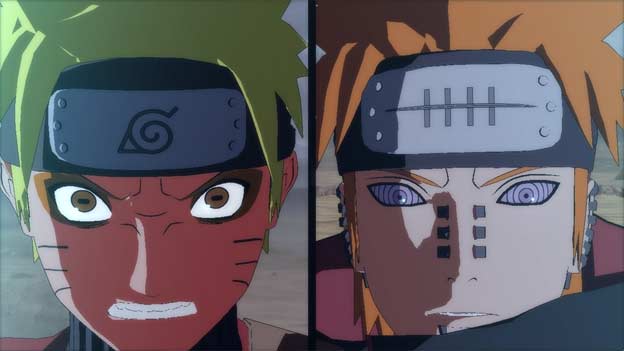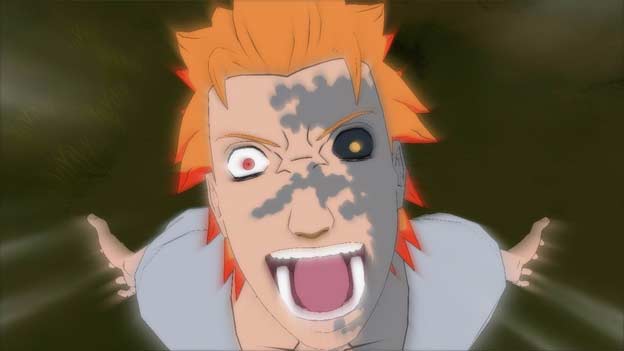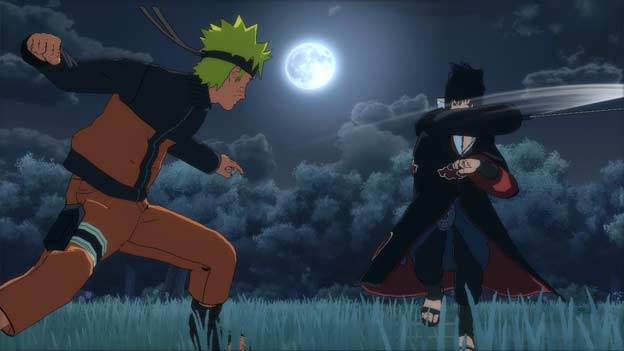The Storm Returns
To most Naruto fans, 2008’s Naruto: Ultimate Ninja Storm is the game by which all other Naruto games must be judged. Ultimate Ninja Storm featured great combat, amazing visuals, and a new mission-based format that was quite a break from the established format that had been seen in other Naruto-licensed titles. When I first started up Naruto: Ultimate Ninja Storm 2, I was expecting a smart update to my favorite Naruto game. Although Ultimate Ninja Storm 2 satisfies on many levels, the sequel is a step backward for the series.

Let’s start with the game’s main adventure mode. As you might expect from the title, the game follows Naruto’s Shippuden journey, through his big battle with Pain. Although we’ve been presented with the beginning of the Shippuden story before, the story is told in the most detail here and is the ultimate way to experience it in video game format (so far). The plot-based cutscenes are taken straight from the anime, and the game also includes several “bonus” scenes that give you extra insight into each character’s feelings after boss battles.
Though the cinematic feel of the game’s story mode is great, the new format of Ultimate Ninja Storm 2 is a drawback for the story mode. One of the things I enjoyed most about the first game was the ability to free-roam around Konoha, picking up missions and talking to locals. However, that ability has been almost completely removed in Ultimate Ninja 2, and the world of Konoha has been reduced to a couple of hallways in which you can go left or right. Or up and down. Which brings me to another complaint: the camera.
Normally I wouldn’t complain about the camera in the story mode of a fighting game, but because Ultimate Ninja Storm’s story mode features a lot of running around in between battles, it is a major problem. When you are running around through the hallways of Konoha, the camera changes to a different fixed position every few feet. I get that the idea here was probably to make the village look less linear, but when the camera keeps changing from overhead to behind, to left-view, and then full circle to right-view, walking towards your goal (which shifts along with the camera angle) can get pretty confusing. In a game where exploring essentially means walking in a straight line, getting lost due to weird camera angles is particularly frustrating.

Fans of the Ultimate Ninja series will be glad to know that the same Ultimate Ninja battle system is in full swing here, although there have been some minor adjustments. The use of Chakra moves is more dynamic in Ultimate Ninja Storm 2, and you’ll have a choice of eight Chakra attacks (each face button gets both a standard and a super chakra attack), which gives you some flexibility even when your chakra is low. The combo system has also been revised, so just hammering on the attack button the same way you did in the past won’t exactly cut it anymore.

Although most of the tweaks to the battle system are positive, there are some little issues that I noticed. One of the first is the heavier reliance on quick-time events to end story battles. The original did feature some quick-time events at the end of important stages, but the reliance on this mechanic seems to have been amped up to the max in this title, with between eight and twelve button combinations ending stages routinely.

The game also uses a new star rating to measure your performance on the quick-time events that can, in turn, unlock special cutscenes. The focus on nailing the quick-time events really detracts from the game’s combat, as you have to always be ready to hit some random buttons instead of nailing a combo or landing a finishing Rasengan. The dueling Chakra system is absent from this game. When two characters activate Chakra attacks in Ultimate Ninja Storm 2, they take turns instead of battling it out with a competitive button smash. Changes like these give the feel that the developers were fixing something that was never broken.
The visuals have been drastically improved. Although I gave high praise to the original Ultimate Ninja Storm for its highly detailed cel-shaded visuals, the follow-up has done the unthinkable and made the visuals even more breathtaking. The cel-shading in this title is incredibly well-done, and absolutely nails the visual style of the Naruto anime. The world of Konoha is also lovingly rendered, and though there isn’t much to explore, the vistas are certainly picturesque. Both cutscenes and in-game visuals hit all the right notes, and this is certainly the best-looking Naruto game yet.
In addition to the game’s adventure mode, there is also an online component to the game which has some fairly interesting points. The interface uses a “Ninja Card” system to track both your stats as well as the battle standings of both friends and rivals. The mode isn’t deep, but if you love taking the fight online, the offering here is satisfactory and you’ll get plenty of hours out of the online battle mode.
Naruto: Ultimate Ninja Storm 2 exceeds its predecessor in many ways. A tighter story, better visuals, and easier-to-manage Chakra system top the list of improvements made since the last iteration. However, I can’t help feeling like there are some major detractors here, including the loss of the free-roaming mission format and the stronger focus on quick-time events. There is a lot to love about Naruto: Ultimate Ninja Storm 2, and if you are a Naruto fan you should certainly pick it up as it is the best Naruto game I’ve seen based on the Shippuden saga and the best Naruto title you’ll see on the Xbox 360 (the original was a PlayStation 3-exclusive). Just don’t expect this follow-up to top its predecessor in every way imaginable. I suppose that is the risk you take when the bar is set so high.
RATING OUT OF 5 RATING DESCRIPTION 4.7 Graphics
Best-looking Naruto game on the PlayStation 3/ Xbox 360 platforms. Cel-shading is perfect and replicates the anime to the letter. 4.1 Control
Familiar fighting controls feel natural, but new Chakra system will take a little bit of getting used to. 3.9 Music / Sound FX / Voice Acting
Both English and Japanese voiceovers sound great. Sampled background music works well. 3.4 Play Value
The game isn’t all that lengthy, but both offline and online multiplayer modes lend some replay value. 4.1 Overall Rating – Great
Not an average. See Rating legend above for a final score breakdown.
Game Features:
